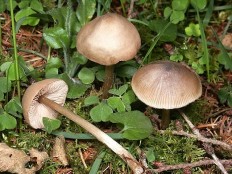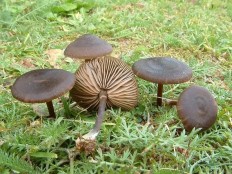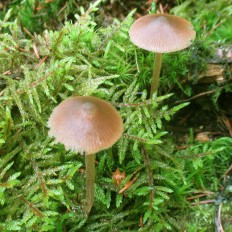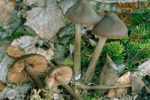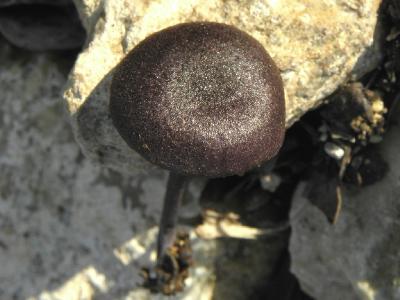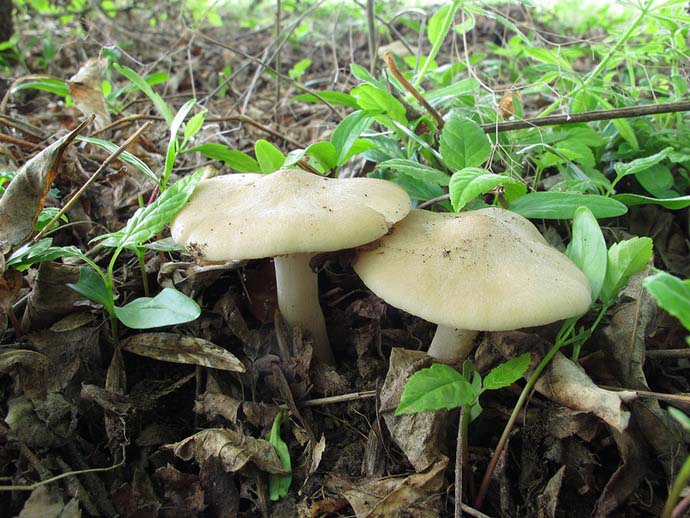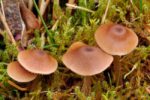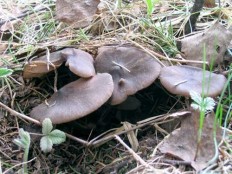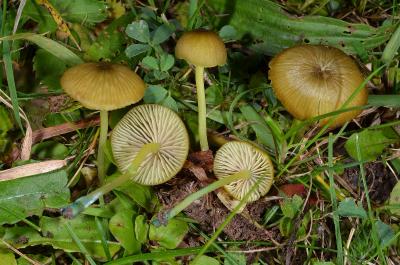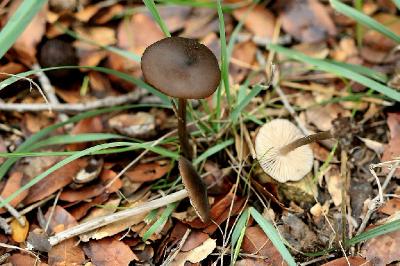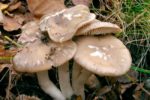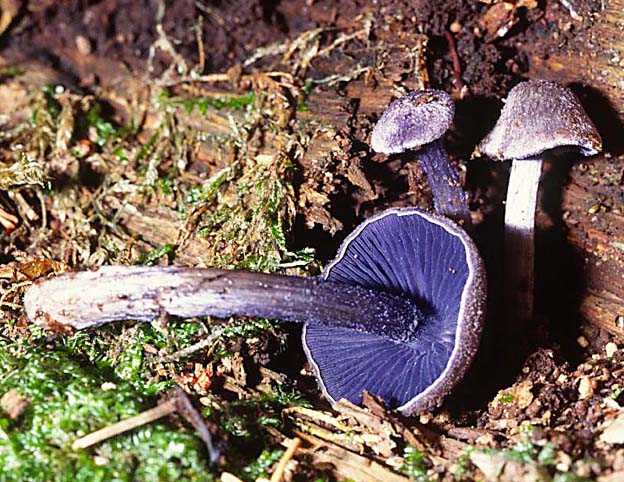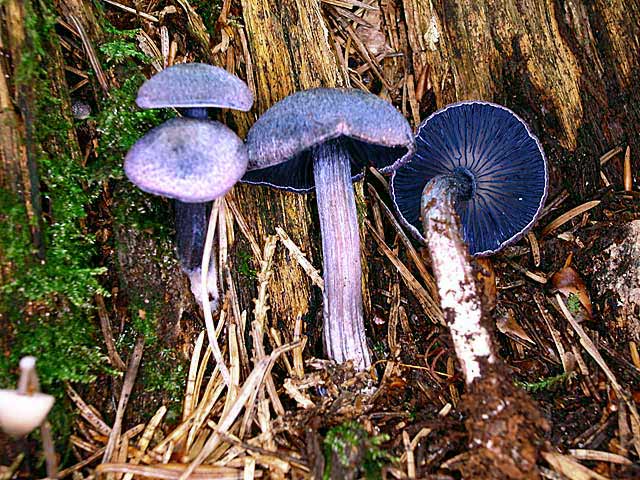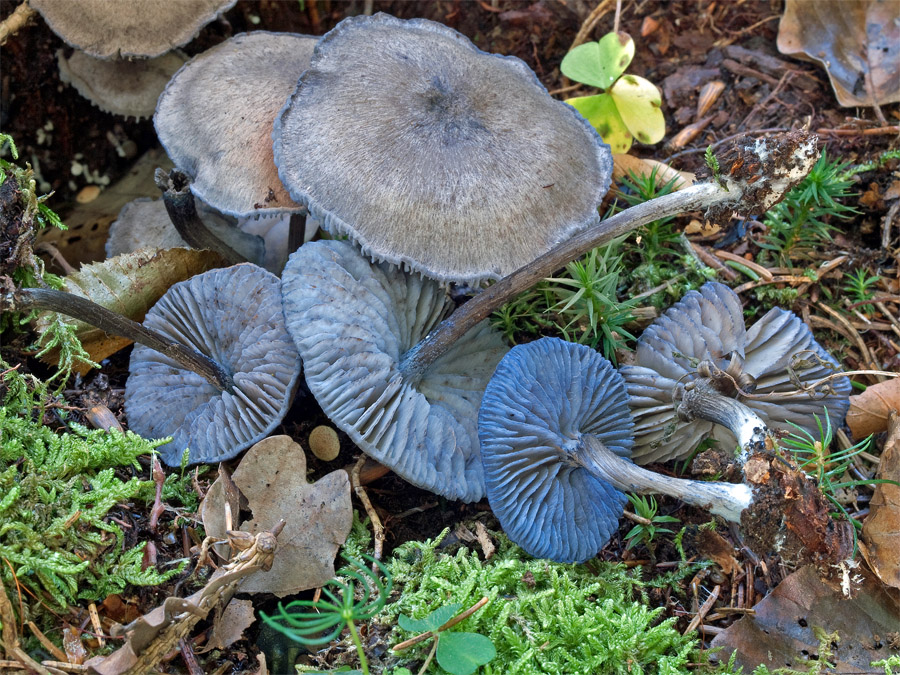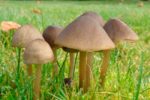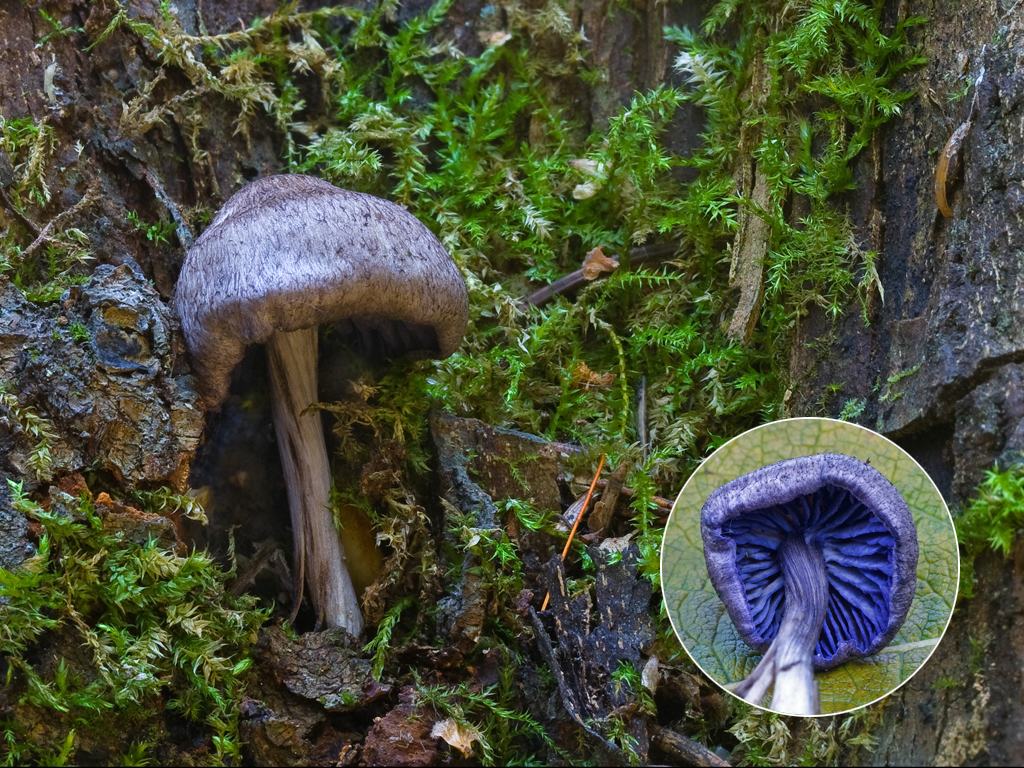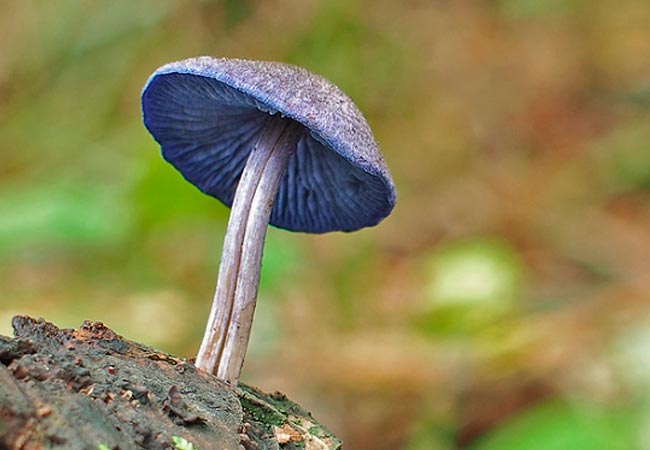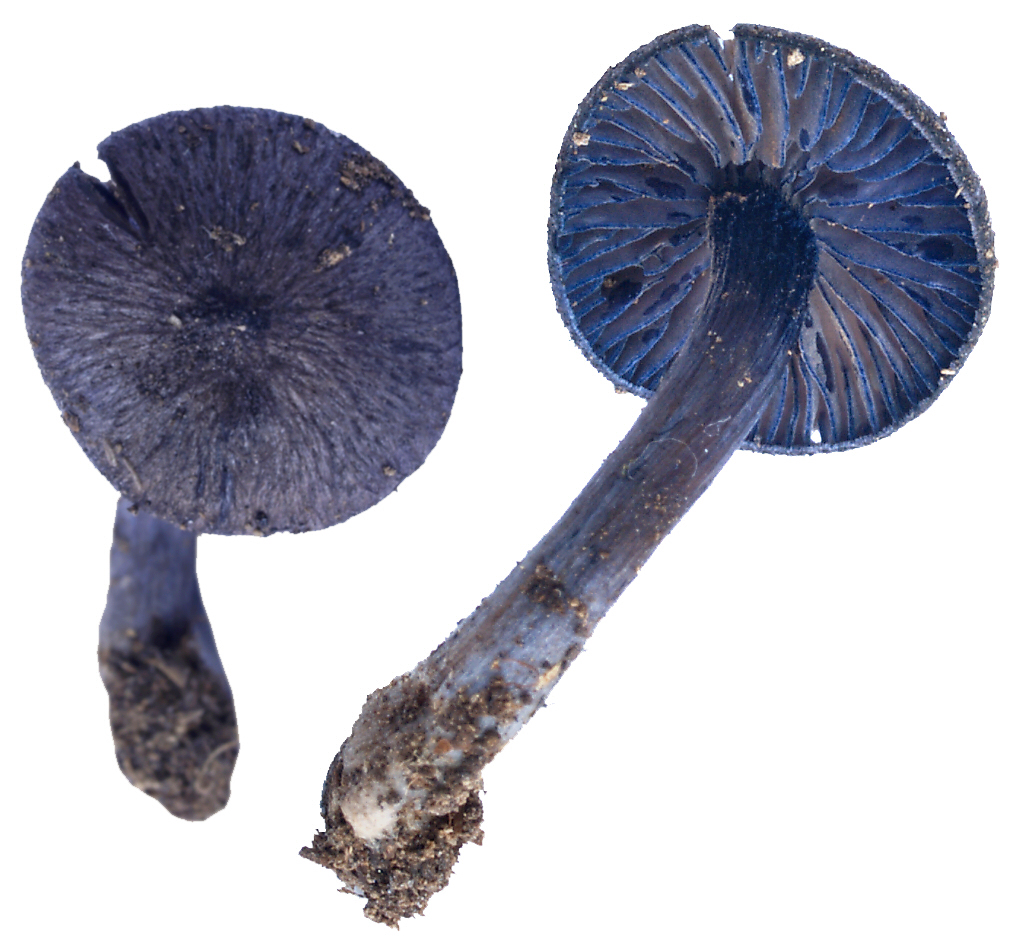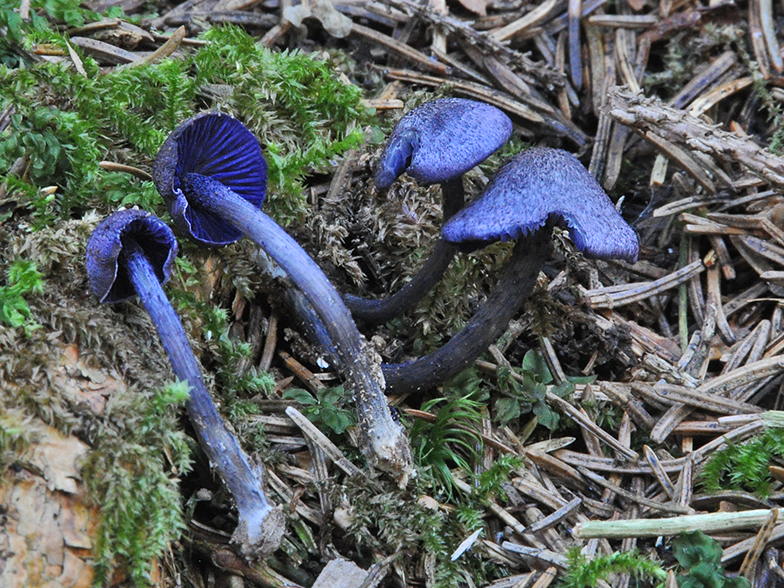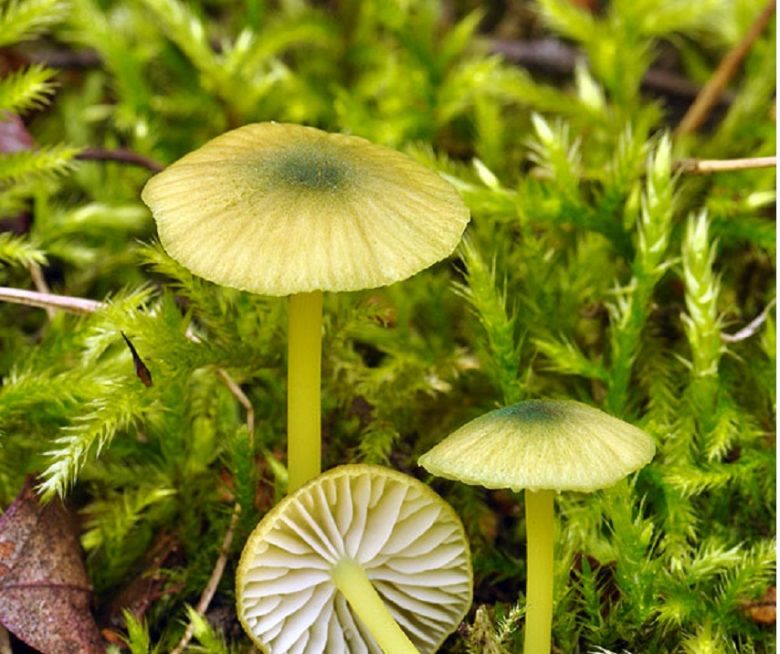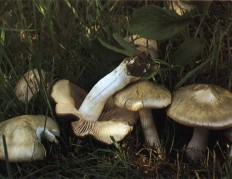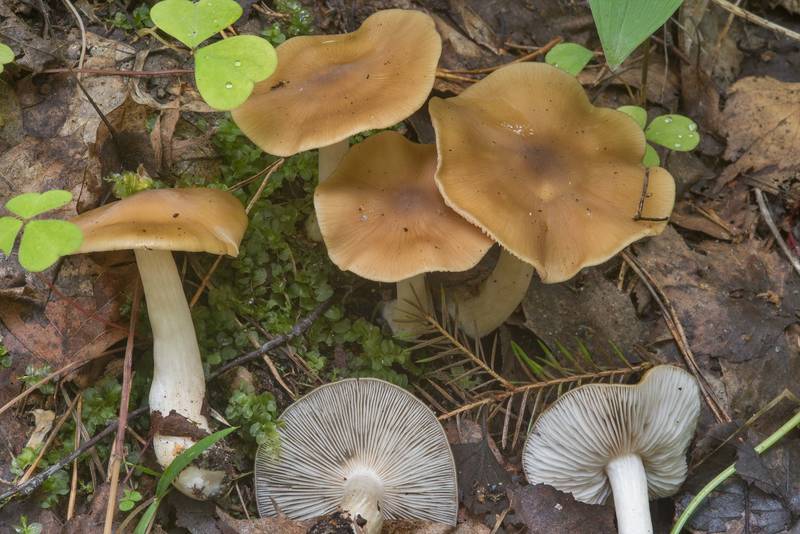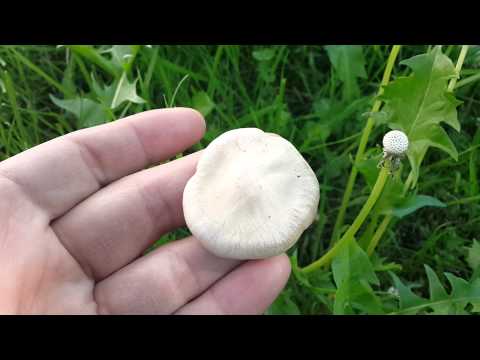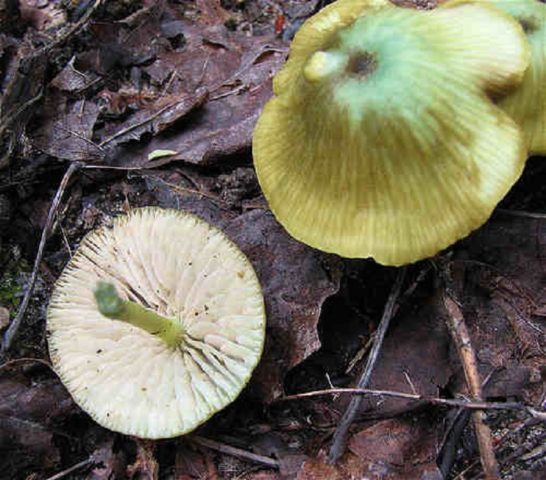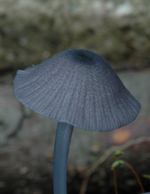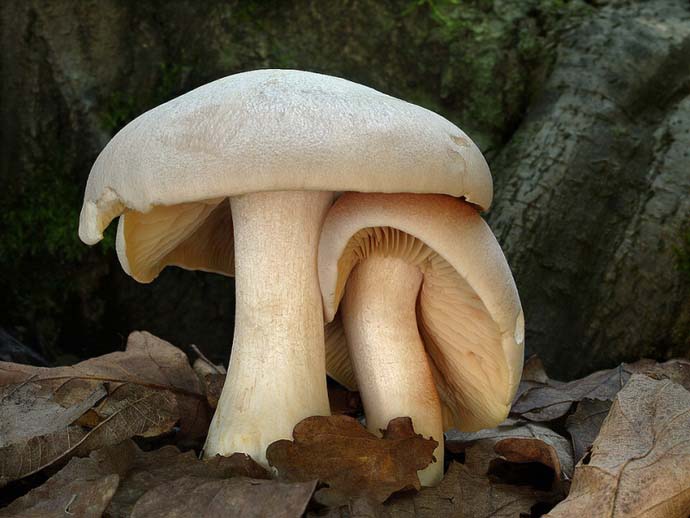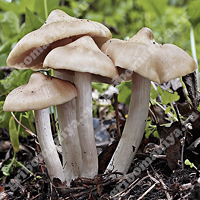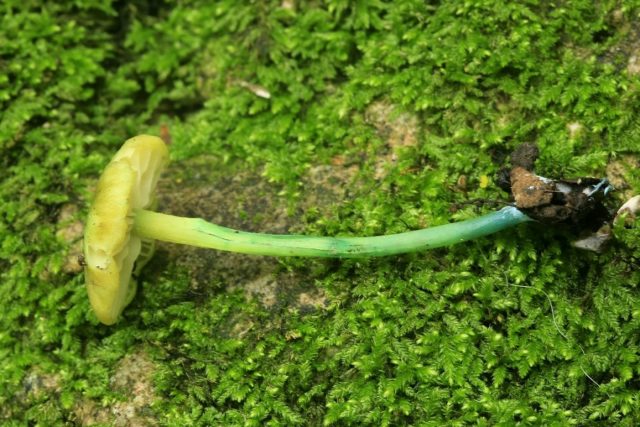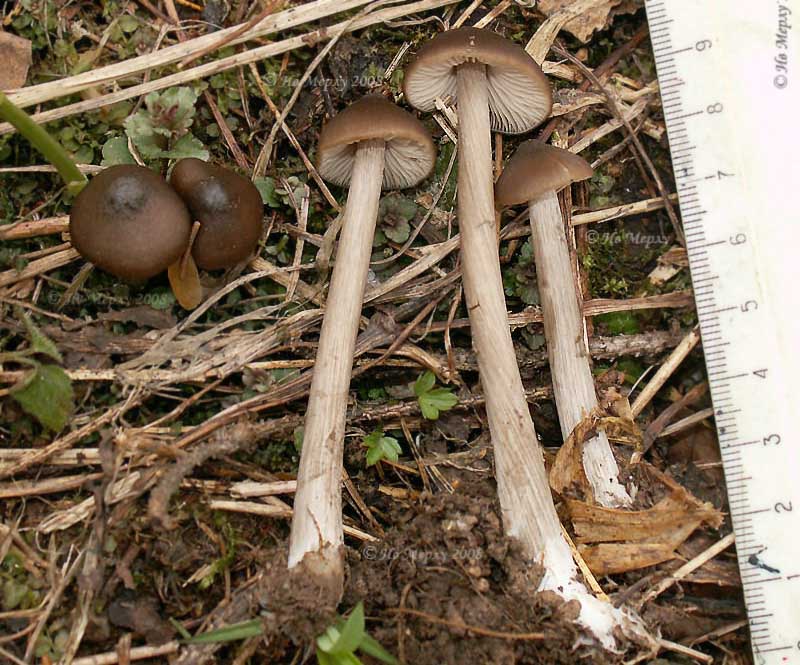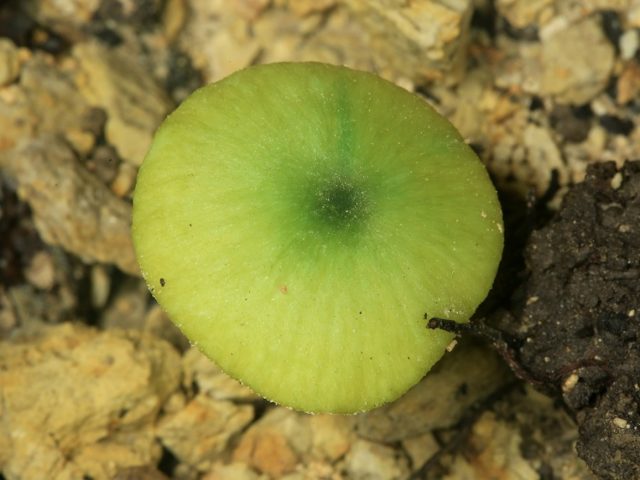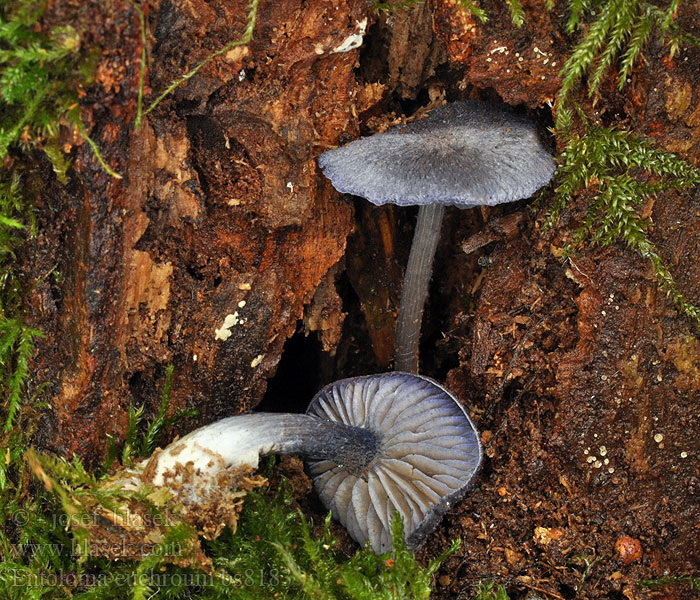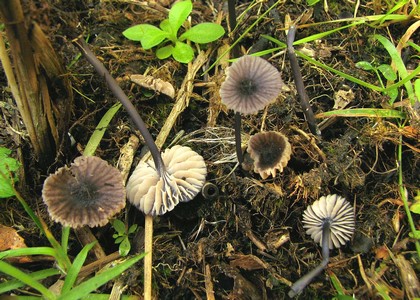Similar species
Poisonous rose-leaf is dangerous for inexperienced mushroom pickers by its similarity with a number of edible species.
- Hawthorn, Clitopilus prunulus Scop. ex Fr. P. Kumm. , mainly differs in the plates descending to the leg, however, it is colored in almost the same way as poisonous pink plate.
- Edible rose leaf garden, Entoloma clypeatum (L.) P. Kumm. ) differs from the poisonous rose-platypus mainly in the hygrophilous cap and in the place of growth - it is found in gardens and meadows, and not in deciduous forests.
- The May row, Calocybe gambosa (Fr.) Donk, has narrow, frequent hymenophore plates, usually adherent, whitish or light ocher in color.
- Smoky talker, Clitocybe nebularis (Batsch) P. Kumm. , differs in narrow, frequent plates of whitish or cream color, weakly descending along the stem and easily separating from the cap. It also has a peculiar floral or putrid smell.
- Row pigeon, Tricholoma columbetta (Fr.) P. Kumm. , has a silky-white cap with colored spots and a flesh that turns pink on the cut.
- The common champignon, Agaricus campestris L., is easily distinguishable from the poisonous rose leaf due to the presence of a ring on the stem and darker plates.
Of the poisonous mushrooms, the related entoloma is pressed down, Entoloma rhodopolium (Fr.) P. Kumm, is very similar to the poisonous rose leaf. ), which is also poisonous.
Definitioner
- Basidia (Basidia)
-
Lat. Basidia. A specialized structure of sexual reproduction in fungi, inherent only in Basidiomycetes. Basidia are terminal (end) elements of hyphae of various shapes and sizes, on which spores develop exogenously (outside).
Basidia are diverse in structure and method of attachment to hyphae.
According to the position relative to the axis of the hypha, to which they are attached, three types of basidia are distinguished:
Apical basidia are formed from the terminal cell of the hypha and are located parallel to its axis.
Pleurobasidia are formed from lateral processes and are located perpendicular to the axis of the hypha, which continues to grow and can form new processes with basidia.
Subasidia are formed from a lateral process, turned perpendicular to the axis of the hypha, which, after the formation of one basidium, stops its growth.
Based on morphology:
Holobasidia - unicellular basidia, not divided by septa (see Fig. A, D.).
Phragmobasidia are divided by transverse or vertical septa, usually into four cells (see Fig. B, C).
By type of development:
Heterobasidia consists of two parts - hypobasidia and epibasidia developing from it, with or without partitions (see Fig. C, B) (see Fig. D).
Homobasidia is not divided into hypo- and epibasidia and in all cases is considered holobasidia (Fig. A).
Basidia is the place of karyogamy, meiosis and the formation of basidiospores. Homobasidia, as a rule, is not functionally divided, and meiosis follows karyogamy in it. However, basidia can be divided into probasidia - the site of karyogamy and metabasidia - the site of meiosis. Probasidium is often a dormant spore, for example in rust fungi. In such cases, probazidia grows with metabasidia, in which meiosis occurs and on which basidiospores are formed (see Fig. E).
See Karyogamy, Meiosis, Gifa.
- Pileipellis
-
Lat. Pileipellis, skin - differentiated surface layer of the cap of agaricoid basidiomycetes. The structure of the skin in most cases differs from the inner flesh of the cap and may have a different structure. The structural features of pileipellis are often used as diagnostic features in descriptions of fungi species.
According to their structure, they are divided into four main types: cutis, trichoderma, hymeniderma and epithelium.
See Agaricoid fungi, Basidiomycete, Cutis, Trichoderma, Gimeniderm, Epithelium.
- Cutis
-
The type of cap skin, consists of creeping non-gelatinized hyphae located parallel to the surface. The surface of the cap looks smooth.
Lat. Cutis.
See Gifa.
Evaluation of taste, initial processing and recipes
The mushroom is classified as conditionally edible. Requires preliminary preparation. Entoloma is first boiled for 20 minutes and only after that it is fried, pickled or salted.
In Russia, dishes from garden enthol are not very popular, but in Western Europe, these mushrooms are popular.
How to cook a roast?
Ingredients:
- entoloma - 800 g;
- red onion - 2 pcs.;
- tomato sauce - 3 tablespoons;
- garlic - 2 cloves;
- lemon juice - 1 tablespoon;
- salt, sugar - to taste.
Preparation:
- Fry the pre-boiled mushrooms.
- Fry the red onion separately until half cooked.
- Stir the tomato sauce, finely chopped garlic, lemon juice, salt and sugar and fry a little.
- Mix all the ingredients and let it brew.
Salting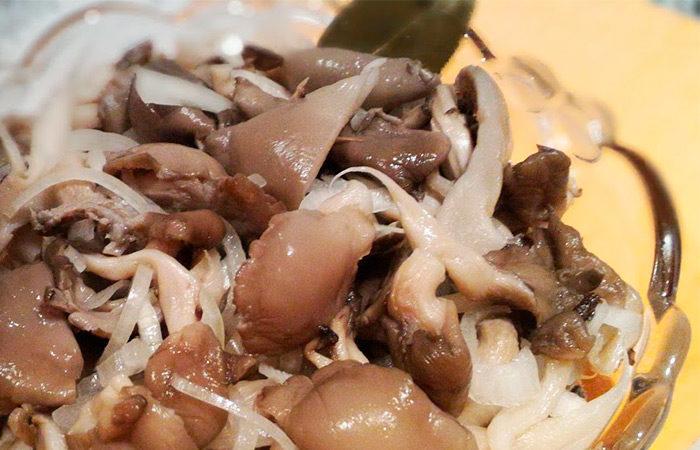
Ingredients:
- mushrooms - 3 kg;
- table salt - 120 g;
- dill (greens, inflorescences or seeds) - to taste;
- black pepper - 30-35 peas;
- bay leaf - 6 pcs.;
- garlic - 4-5 cloves.
Cooking method:
The pre-boiled mushrooms are laid out in a salting container with all the other ingredients in the following order:
- A bay leaf, chopped garlic and dill, as well as black pepper are placed on the bottom.
- Mushrooms are placed on the spices in a layer of about 7 cm and sprinkled with salt.
- Lay out a few more layers to the edge of the container.
- Cover the blank with a napkin, put the load on top and put it in a dark place for a month.
- After the necessary time, the rose-colored plates will be ready for use.
Marinovka
For cooking you will need:
- 0.5 kg of boiled mushrooms;
- 80 g apple cider vinegar 5%;
- 120 g of vegetable oil;
- 2-3 cloves of garlic;
- 10 black peppercorns;
- 1 tsp salt;
- 2 tsp Sahara;
- 4 things. bay leaf.
Cooking method:
- Press the garlic through a press.
- Put all the ingredients in a deep frying pan, cover with a lid, put on medium heat and simmer for 10 minutes.
- Cool, transfer to a jar and refrigerate for 4 hours.
Areas of growth of garden entholm.
Garden entoloms are found in mixed and deciduous forests. They grow under birches, mountain ash and oak trees. They prefer to settle on nutrient rich soil. Mushroom pickers find garden entolomes in meadows, along roads, in gardens, on lawns. In the garden, they grow under fruit trees, mainly pears and apple trees, as well as under rose hips, blackthorns, hawthorns, and rose bushes.

On the territory of the Leningrad Region, garden entolomas are common mushrooms, but they grow pointwise. Fruiting from May to late July, and the peak is observed in June. Often fruiting occurs not in one, but in several short layers. Usually they grow in groups, often the groups can be quite large, and rarely come across alone.
Garden entolomes are widespread in the world; they grow in Western Europe, North America, the European part of Russia and Ukraine. In warm regions, their fruiting begins in April.

Double entoloma garden.
The pale brown entoloma is very similar in appearance to the garden entoloma. This is also an edible mushroom. Its color is cream, brownish-greenish or brownish-gray. Descending plates. The leg is long, shiny, white. The pale brown entoloma also grows in gardens, on lawns, among thickets of bushes. Fruiting from May to June.
Both species are edible, the main thing is not to confuse them with poisonous or tin entola. The main difference between a poisonous entoloma is its large size (its cap can be about 20 centimeters in diameter), an easily removable skin, a yellowish color of the plates, a thick club-shaped leg, of the same color with a cap, and an unpleasant smell of pulp (but sometimes the smell is almost imperceptible). Another feature of poisonous enthol is that they are not found in the north.

There are also two relatively similar venomous species.Squeezed entoloma has a thin brown or creamy yellow cap, and its flesh emits an ammonia smell. Entoloma squeezed from August to October bears fruit. And the second species is the spring entoloma, which has a darker color, slender and small. This species bears fruit from April to May.
Evaluation of the edibility of garden entoloma.
This mushroom is conditionally edible. Garden entolomy should be boiled for 20 minutes, and only then fry, pickle or salt. In the southern parts of Russia, dishes from garden entholm are very rare, but in Western Europe these mushrooms are considered one of the best.
Entoloma brightly colored
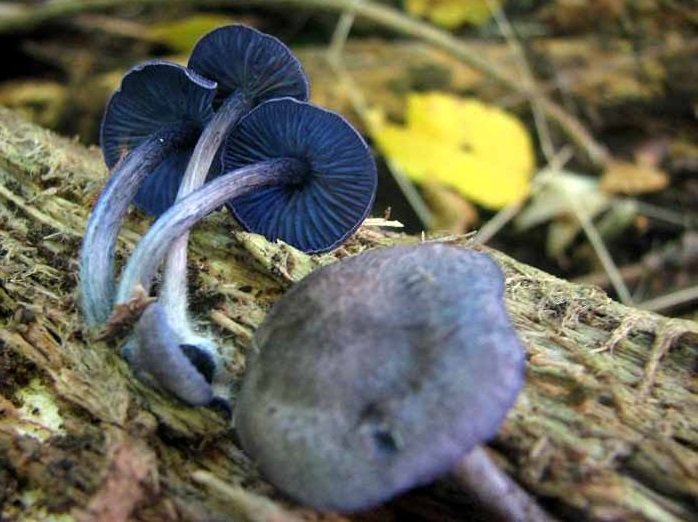
Entoloma brightly colored (Entoloma euchroum)
Brightly colored entoloma can be seen on various continents - in Europe, Asia, in North America. But the mushroom is rare, and therefore infrequent.
Usually grows in late September - October. Prefers deciduous forests, as it grows on birch, alder, oak, ash, mountain ash. It can grow on hazel, and also, however, very rarely, on conifers (cypress).
In Russia, the appearance of such a fungus was noted in the central part, in Western and Eastern Siberia, in some southern regions (Stavropol region). Entoloma euchroum features a bright purple bonnet and blue plates.
The fruiting body is a cap and a leg, while the leg can reach up to 7-8 centimeters in length. In young mushrooms, the cap has the shape of a hemisphere, then it straightens out, becomes almost flat. There is a depression in the middle of the cap.
Color - bluish, purple, gray, at a more mature age, the surface changes color, becomes brown. Brightly colored entoloma plates also have a blue or purple color, maybe with a gray tint.

The hat is set on a cylindrical stem - with scales, hollow, with a slight bend. There may be a small fluff at the bottom of the leg. Coloring - either the same color as the cap, or gray.
The pulp is very fragile, has an unpleasant specific smell and soapy taste. At the same time, depending on the age of the mushrooms, the smell can change, from sharp and rather unpleasant to perfumery.
The fungus Entoloma euchroum belongs to the inedible species, but the edibility of the species has not been thoroughly studied.
Entoloma squeezed
Squeezed entoloma - lat. Entoloma rhodopolium
Otherwise, it is called Champignon squeezed, Entoloma pink-gray, Entoloma fuming, Champignon fuming, Rose-leafed autumn, Entoloma gray or Rose-leafed fuming.
Mushroom cap
The caps of the Autumn Pink Platter reach 25-120 mm in diameter. At first they are convex, later the hats spread out until they become squeezed - convex. The middle is crowned with a dark mound, after which a hole forms in it.
The smooth hat surface is characterized by a hygrophilous structure and changes color depending on the weather: on damp days it turns red or slightly brown, on dry days it becomes brownish gray or olive gray.
The edges of the hats are even and slightly tucked wavy; in old mushrooms they crack a little. They are somewhat translucent and have radial stripes.
Hat pulp Entolomes pink - gray usually tasteless, transparent white and fragile. It either does not smell or exudes a strong smell of alkali or nitric acid.
The bottom of the hats is filled with medium-frequency, wide, uneven plates that grow on the legs and subsequently with teeth descending along them. They are of different lengths. Young Entoloma has a sagging plate white or white - gray, sometimes with pink spots. In adult rosacea, the plates are deep pink, in old ones they are dirty yellow-pink.
Squeezed champignon reproduces by rounded - angular spores contained in a dirty pink spore powder.
Stipe
The fuming rose-leaf has a flattened cylindrical leg that grows up to 5-15 mm in thickness and 35-100 mm in height. It may thicken slightly downward or upward.
The surface of the legs is colored white, pale gray or light brown and remains smooth.A tiny whitish pile appears near the hat.
Legs of juveniles are filled with pulp from longitudinal fibers, adults are empty. The ring is not available.
Entoloma squeezed (Entoloma rhodopolium)
Growing places
Entoloma gray is found on damp grassy soils with fallen leaves of elms and birches; it rarely grows in conifers.
Fruiting occurs in groups - in the form of small or large groups, rings or rows and falls on the August-September days.
Edibility
Due to the high content of toxins, the Thinning Rose Platter belongs to inedible and even poisonous mushrooms. Eating it in food leads to severe food poisoning, in large quantities - to death.
Entoloma poisonous
Poisonous entoloma - lat. Entoloma sinuatum
In a different way, a dangerous mushroom is called Entoloma tin, Rosovoplastinnik gigantic, Rosovoplastinnik poisonous, Entoloma notched-lamellar, or Rosovoplastinnik yellowish-glaucous.
Mushroom cap
Pewter entoloma builds up a giant cap with a diameter of up to 25 cm. The hats of young mushrooms at first have a convex rounded or bell-shaped shape, after which they spread out or remain convex-flat.
The edges of the caps are at first tucked up, as they mature, they are lowered, even or wavy. In the center of the mushroom, a sloping mound is preserved; in old mushrooms, a notch often appears.
The glossy silky skin becomes sticky in wet weather. It is painted gray-ocher or grayish-white, with age turning into a gray-brown shade with an ash tint.
The inside of the hats has a fleshy white flesh that turns brown under the skin and does not change color after damage. The flesh of a young pink-colored plate smells like flour, while old mushrooms exude a rancid odor. It is tasteless or has a bitter taste.
The bottom of the hat is speckled with weakly growing thin plates 8-15 mm wide. Young plates are grayish-yellow in color, while mature ones are pink or reddish with a dark edge.
Giant pink laminae reproduces by angular spores, forming them in pink spore powder.
Stipe
Entoloma poisonous has a powerful cylindrical or clavate leg, bending downward, the diameter of which is 10-35 mm, and the length is 40-150 mm. At a young age, the legs are filled with pulp, which later turns into a spongy mass.
The leg is covered with a smooth silky white skin that turns gray or yellow with time. If you press on it, it will turn slightly brown. The lower part remains smooth, the upper part is covered with a mealy bloom.
Entoloma poisonous (Entoloma sinuatum)
Growing places
Poisonous rose-leaf is a rare mushroom that prefers heavy clay or limestone soil of light deciduous and mixed forests and parks with beech, oak, hornbeam, willow and birch trees. It is found in the South Siberian, North Caucasian and European parts of Russia, as well as in Ukraine.
Single and numerous fruiting occurs at the end of May - beginning of October.
Edibility
The name of the mushroom speaks for itself: Poisonous entoloma is very toxic. Its use causes severe food poisoning, accompanied by fever, vomiting, abdominal pain, etc. If you eat a large number of mushrooms, you can die.
Entoloma brightly colored Entoloma euchroum
Syn: Agaricus euchrous Pers., 1801 Hyporrhodius euchrous (Pers.) J. Schrot., 1891 Leptonia euchroa (Pers.) P. Kumm., 1871
Forum Back Home List of species Letter to author
Last page update -
The description of the mushroom was made by Elena Lukashina with the participation of Alexander Zykov, Vladimir Kapitonov, Lyubov Kirilova, Olga Morozova, Alexey Myasnikov, Kim Potapov, Tatiana Svetlova.
Click on the marker to get additional information about the find of this species If you still know the place of growth of this species, please determine its coordinates and send them to the site
Description of the mushroom completed Additionally Section-3
On off. mushroom find map
| Full scientific name | Entoloma euchroum (Pers.) Donk, 1949 |
| Common names | CZ: Závojenka modrá (Czech Republic) DE: Violetter Holzrötling (Germany) PL: Dzwonkówka fioletowawa (Poland) SK: Hodvábnica fialovomodrá (Slovakia) SE: Lilanopping (Sweden) FR: Entolome tout bleu (France) FI: Siniparus (France) |
| Short description | Rare view. It is found in moist deciduous and mixed forests. It is well identified by a combination of the following features: pronounced purple color in the color of the cap, bright blue (bright purple) plates, fibrous-scaly stem and habitat on deciduous wood |
| Hat Cap | A hat with a diameter of 1-5 cm, at first hemispherical, conical, then straightens to almost flat, sometimes with a central depression or a small tubercle, radially silky-fibrous, with a silky sheen, finely scaly in the center, non-hygroscopic, not radially striped, purple, bluish-gray, grayish-lilac, with age it becomes brown with various violet or blue tints, the edge is even, tucked up in young specimens, sometimes it splits radially in old age. |
| Gills records | The plates are rare, attached by a descending tooth, purple, blue, dark blue, sometimes purple-gray or purple-brown with a darker bright purple edge. |
| Spores controversies | Spore powder pink. |
| Micromorphology Micromorphology | Spores 8-12 x 5-8 microns, angular (with 5-7 angles). Basidia are 4-spore, cheilocystids are numerous, 20-60 x 5-15 microns, cylindrical, clavate with brown-violet intracellular pigment. |
| Stem leg | Leg 2-7 cm long, 1-4 mm thick, cylindrical, sometimes slightly thickened at the base, even or slightly curved, thin, fragile, hollow, one-color with a cap, dark blue, purple, with a gray or brown tint, scaly, longitudinally fibrous-striped, sometimes with whitish pubescence in the lower part. |
| Flesh pulp | The pulp is pale blue or light lilac, thin, fragile. Mealy or unpleasant soapy taste, odor from expressionless to aromatic-perfumery, violet |
| Habitat habitat | It grows in moist deciduous and mixed forests on living and dead wood of deciduous trees (alder, oak, beech, birch, hazel, ash, mountain ash), as an exception - on conifers (cypress). |
The species is widespread in Europe, Asia and North America, but is quite rare. On the territory of Russia, it is noted in the European part (Moscow, Ryazan regions, Stavropol Territory, Karachay-Cherkessia (Teberda)); in Western Siberia (Tomsk region); in Eastern Siberia (Republic of Tyva).
Edibility Edibility
The edibility of the species has not been studied.
Other photographs of this mushroom in the WEB
Search fungus pictures on the internet like Entoloma euchroum
Similar species
There are several types of bluish, bluish or purple entoloma, two groups of mushrooms similar to Entoloma euchroum can be distinguished:
1. Forest species, usually growing on wood and having a fibrous-scaly leg: Entoloma tjallingiorum, Entoloma allochroum, Entoloma dichroum, Entoloma chytrophilum. These species have mostly light (not blue) plates.
2. Species growing mainly in meadows and having a more or less smooth stem: Entoloma mougeotii with light blades, and species with blue blades - Entoloma serrulatum, Entoloma chalybeum. A forest species growing on the soil - Entoloma lepidissimum is small in size, with a blue cap, a blue fibrous-scaly leg and sometimes bluish plates.
Description of entoloma crushed
The cap is 3-10 centimeters in diameter with the entoloma. The young cap is convex, and with age it becomes prostrate and even reaches a depressed one with a dark tubercle in the central part. The structure of the cap is hygrophilous. The color of the cap changes significantly, which is influenced by moisture. When dry, the cap is gray-brown or olive-brown, and after rain it turns reddish or brown.
The pulp is thin, whitish in color. The pulp may not smell or smell like lye. A variety with an alkali odor was previously isolated into a special species - Entoloma nidorosum.The plates are wide, located with an average frequency, adherent to the pedicle. At first, the color of the plates is white, and with age they turn pink. Spore powder of pink color.
The leg is cylindrical, flat, high - it can reach a height of 10 centimeters, while it is thin - no more than 0.5 centimeters wide. The color of the leg is white or grayish.
Distribution of entoloma pink-gray
Entolomas squeezed in August-September bear fruit. These mushrooms prefer deciduous forests. They are quite abundant in damp places.
Similar species
Pink-gray entolomes have a quite ordinary appearance, so they can literally be confused with any mushrooms. Their distinctive characteristic is the discs that turn pink with age.
Outwardly, entolomes are similar to pluteia, but they grow on the soil, and spitters settle on stumps.
From its counterparts (other enthol) entoloma, the squeezed one differs in a strong ammonia smell, and in similar species, the smell, on the contrary, is pleasant, floury.
Related species
Garden entoloma is a conditionally edible mushroom. Her hat is first bell-shaped, then convex-concave, smooth, sticky in the rain, up to 12 centimeters in diameter. The color of the cap is whitish-gray, beige, gray-brown. The leg is often twisted, up to 10 centimeters high, slightly furrowed, grayish or pink in color.
Garden entolomy grows under birches, mountain ash and oak trees. They inhabit forests, meadows, city lawns and gardens. In gardens, these mushrooms are found under fruit trees - pears, hawthorns, apple trees. Most often they do not appear in groups, sometimes groups can be quite large.
Spring entoloma is a poisonous mushroom. Her hat is conical, 2-5 centimeters in diameter, gray-brown or black-brown in color with an olive tint. The stem is fibrous, somewhat thickened at the base, 3-8 centimeters high. The color of the leg matches the cap or is slightly lighter.
Spring entolomes bear fruit from May to June. Mostly they come across on forest edges. Spring entolomes settle on sandy soils.
Description of poisonous entoloma
Entoloma venomous is the largest member of the genus. The diameter of its cap is most often 5-17 centimeters, but can reach 25 centimeters. The color of the cap in young specimens ranges from grayish-ocher to off-white; with age, the color becomes ash or gray-brown. The cap is smooth, sometimes there may be small folds in the central part. In wet weather, the cap becomes a little sticky, and when it dries, it becomes shiny.
The shape of the cap at a young age is hemispherical, it can be conical-bell-shaped with a rolled edge, over time it becomes flat-convex with a blunt wide tubercle in the center and a wavy or even edge, and in very old mushrooms it can become sunken.
The flesh of the rose leaf is thin and dense. At a break, the color of the pulp does not change. The taste is unpleasant and the odor can be mealy or rancid. The blades are sparse, wide, notched or with weakly adherent teeth. The color of the plates is first dirty yellow, then yellow-pink, pinkish or red, while the edges are darker.
The height of the leg of the poisonous entoloma ranges from 4 to 15 centimeters with a thickness of 1-3.5 centimeters. The stem is central, cylindrical, most often curved and thickened at the base. At first, the leg is dense, but in adulthood it becomes spongy. The surface of the leg is silky, white, and later grayish or ocher-yellow. If you press on the leg, it will turn pale brown. In the upper part of the leg there is a mealy bloom, and below it is naked.
Spore powder of pink color. Spores are hexagonal, slightly elongated, pink-yellow in color, smooth, with one or two drops of oil.
Ecology and distribution of the poisonous rose-leaf
Poisonous entoloma is a relatively rare fungus that grows sparsely. These mushrooms grow in the soil. The fruiting season begins at the end of May. They are found in mixed and deciduous forests, most often in parks and oak forests.
They form mycorrhiza with beech, oak, hornbeam, and in more rare cases - with willow and birch. Poisonous rose-leafed plants prefer heavy soils with a high lime content. These mushrooms live singly or in small groups. This is a thermophilic type of mushroom. On the territory of our country, they are found in the south of the European part and the northern Caucasus, and also grow in the south of Siberia.
Toxicity of the giant rose-leaf
It is a gastrointestinal poisonous fungus that, when eaten, irritates the gastrointestinal tract. Poisonous entoloma provokes a resinoid syndrome, accompanied by vomiting, abdominal pain and loose stools. These symptoms appear already after 30 minutes - 2 hours after the ingestion of toxins. It all starts with a headache and dizziness, and then diarrhea and severe vomiting are added.
As a rule, recovery occurs after 48-72 hours, but if a person has eaten a large amount of poisonous mushrooms, death can occur.
Poisoning treatment
Treatment consists in gastric lavage and the appointment of saline-type laxatives, as well as enterosorbents.
If severe gastroenteritis has developed, saline and glucose are administered to the victim. In addition, everyone else who used poisonous entoloma, and who did not show symptoms of poisoning, also washed the stomach and prescribed laxatives and enterosorbents.
Similar species
The danger of the rosacea lies in its resemblance to a number of poisonous mushrooms:
• The edible rose-leaf garden can be distinguished from its poisonous counterpart thanks to its hygrophilous cap and habitat - these mushrooms grow in meadows and gardens, and not in forests;
• Hanging plant is recognized by the plates descending to the leg, but its color is practically the same as poisonous entoloma;
• May ridge is characterized by frequent, narrow blades, mostly adherent, of light ocher or whitish color;
• The pigeon row is distinguished by a silky white cap with colored spots and flesh, which becomes pink on the cut;
• Smoky talker has narrow, often spaced cream or whitish plates, which slightly descend along the stem and are easily separated from the cap. The smoky talker smell can be floral or putrid;
• The common champignon can be easily distinguished from the poisonous rose leaf with the help of a ring on stem and plates of a darker color;
• The pigeon row is characterized by a silky cap with colored spots and a pinkish flesh on the cut.
Among poisonous mushrooms, the greatest similarity is observed with the pressed entola. But the entholoma pushed through, just like the poisonous rose-leaf, is not harvested, so it is not scary to confuse these mushrooms.

